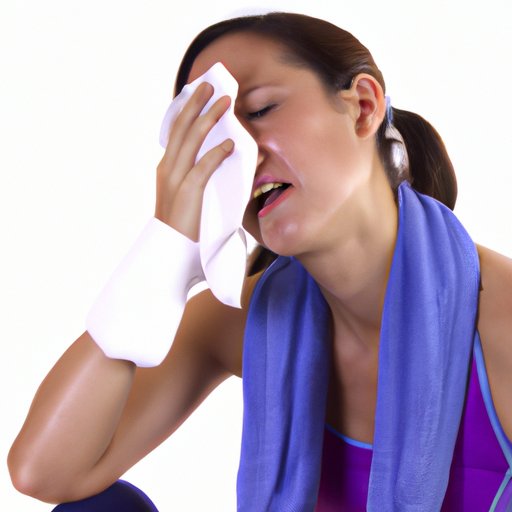Introduction
Feeling nauseous after a workout can be incredibly discouraging, especially if you’re trying to stay motivated and consistent with your exercise routine. Fortunately, there are several steps you can take to reduce or even prevent post-workout nausea. In this article, we’ll explore how to stop feeling nauseous after working out, from hydrating to taking breaks to cooling down.
Hydrate
Staying hydrated is essential for any workout routine, but it’s especially important if you want to avoid feeling nauseous. According to the American Council on Exercise, “Dehydration can lead to lightheadedness, fatigue, and nausea—all of which can contribute to an unpleasant workout experience.” To ensure that you stay hydrated pre- and post-workout, try to drink at least 16 ounces of water two hours before exercising, 8 ounces of water 15 minutes prior to working out, and 8 ounces of water every 15 minutes during your workout. Additionally, drinking about 8 ounces of water within 30 minutes after exercising can help replenish lost fluids.
Eat Properly
Eating a healthy meal or snack before exercising can help prevent post-workout nausea. A study published in the journal Appetite found that eating a low-fat meal before exercising reduced feelings of nausea among participants. The study also found that eating a high-fat meal before exercising increased levels of nausea. So, when fueling up before a workout, try to focus on lean proteins, complex carbohydrates, and healthy fats. Examples include a turkey sandwich on whole-grain bread, oatmeal with berries, or a banana with almond butter.
Take Breaks
Taking breaks during your workout can help reduce feelings of nausea. According to the Mayo Clinic, “Resting periodically gives your body a chance to recover and helps you avoid becoming overly fatigued.” If you’re doing an intense workout, aim to take a break every 10 to 15 minutes. During your break, try to walk around for a few minutes or do some gentle stretching to keep your blood flowing. This will help prevent your heart rate from dropping too quickly, which can increase feelings of nausea.
Breathe
Deep breathing is another way to reduce feelings of nausea during or after a workout. According to the American Osteopathic Association, “The rhythmic nature of deep breathing sends a signal to the brain to relax, which can reduce feelings of nausea.” To practice deep breathing, start by inhaling slowly through your nose, counting to four. Then exhale slowly through your mouth, counting to four. Repeat this process several times until you start to feel more relaxed.
Cool Down
Cooling down after a workout is important for preventing nausea. According to the Harvard Health Publishing, “A cool-down period allows your heart rate and breathing to return to normal gradually.” To cool down, try walking or jogging at a slow pace for five minutes. You can also do static stretching after your workout, which involves holding each stretch for 10 to 30 seconds. This will help your muscles relax and get rid of any lactic acid buildup.
Rest
Finally, getting enough rest is essential for preventing post-workout nausea. According to the American College of Sports Medicine, “When you’re overtraining, your body doesn’t have time to recover, which can lead to feelings of nausea and dizziness.” Aim to get seven to nine hours of sleep each night, and make sure to take at least one day off from exercising each week. This will give your body the time it needs to rest and recover.
Conclusion
Feeling nauseous after a workout can be discouraging, but it doesn’t have to be. By following these tips—hydrating, eating properly, taking breaks, breathing, cooling down, and resting—you can reduce or even prevent post-workout nausea. So next time you hit the gym, keep these tips in mind and enjoy your workout without the worry of feeling sick afterward.
(Note: Is this article not meeting your expectations? Do you have knowledge or insights to share? Unlock new opportunities and expand your reach by joining our authors team. Click Registration to join us and share your expertise with our readers.)
